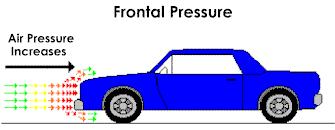Difference between revisions of "Drag"
m |
m |
||
| Line 17: | Line 17: | ||
[http://en.wikipedia.org/wiki/Drag_%28physics%29 Wikipedia On Drag] | [http://en.wikipedia.org/wiki/Drag_%28physics%29 Wikipedia On Drag] | ||
| + | |||
[http://en.wikipedia.org/wiki/Fluid_dynamics Wikipedia On Fluid Dynamics] | [http://en.wikipedia.org/wiki/Fluid_dynamics Wikipedia On Fluid Dynamics] | ||
| + | |||
[http://en.wikipedia.org/wiki/Turbulence Wikipedia On Turbulence] | [http://en.wikipedia.org/wiki/Turbulence Wikipedia On Turbulence] | ||
Revision as of 12:23, 16 January 2007
Drag
A simple definition of aerodynamics is the study of the flow of air around and through a vehicle, primarily if it is in motion. To understand this flow, you can visualize a car moving through the air. As we all know, it takes some energy to move the car through the air, and this energy is used to overcome a force called Drag.
Drag, in vehicle aerodynamics, is comprised primarily of two forces. Frontal pressure is caused by the air attempting to flow around the front of the car. As millions of air molecules approach the front grill of the car, they begin to compress, and in doing so raise the air pressure in front of the car. At the same time, the air molecules travelling along the sides of the car are at atmospheric pressure, a lower pressure compared to the molecules at the front of the car.
Just like an air tank, if the valve to the lower pressure atmosphere outside the tank is opened, the air molecules will naturally flow to the lower pressure area, eventually equalizing the pressure inside and outside the tank. The same rules apply to cars. The compressed molecules of air naturally seek a way out of the high pressure zone in front of the car, and they find it around the sides, top and bottom of the car.
Rear vacuum (a non-technical term, but very descriptive) is caused by the "hole" left in the air as the car passes through it. To visualize this, imagine a bus driving down a road. The blocky shape of the bus punches a big hole in the air, with the air rushing around the body, as mentioned above. At speeds above a crawl, the space directly behind the bus is "empty" or like a vacuum. This empty area is a result of the air molecules not being able to fill the hole as quickly as the bus can make it. The air molecules attempt to fill in to this area, but the bus is always one step ahead, and as a result, a continuous vacuum sucks in the opposite direction of the bus. This inability to fill the hole left by the bus is technically called Flow detachment.
